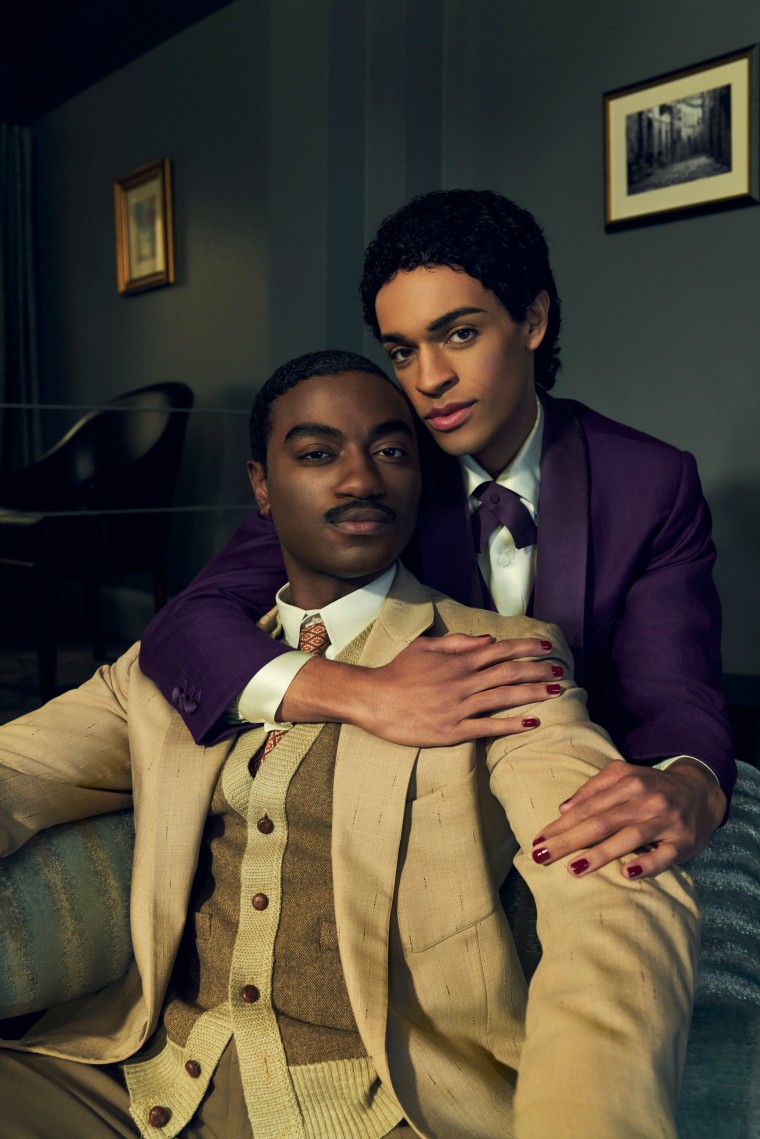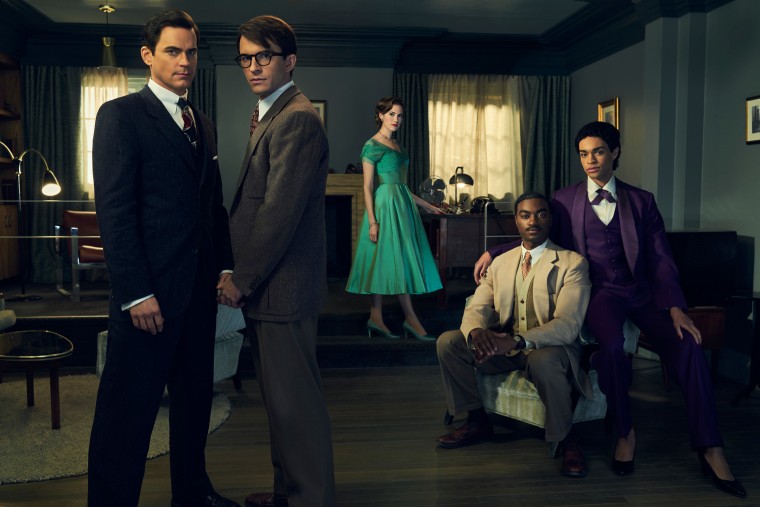Ron Nyswaner has long been interested in the ways in which human sexuality intersects with the law, having written the screenplays for “Freeheld,” “Soldier’s Girl” and “Philadelphia” (the groundbreaking legal drama for which Tom Hanks won the Academy Award in 1994). But with “Fellow Travelers,” the limited series that premieres Friday on Paramount+ and Sunday on Showtime, the Oscar-nominated screenwriter has spearheaded the ambitious adaptation of a decadeslong love story that marks the culmination of his life’s work.
Based on Thomas Mallon’s 2007 novel of the same name, the eight-part series chronicles the deeply passionate romance between two political staffers: Hawkins “Hawk” Fuller (Matt Bomer) and Tim Laughlin (Jonathan Bailey). Hawk, a debonair State Department employee, and Tim, a wide-eyed recent college graduate, fall in love after meeting on the night of Dwight D. Eisenhower’s presidential victory in 1952, just as Sen. Joseph McCarthy and his chief legal counsel, Roy Cohn — determined to root out any communists and queer people working in the U.S. government — incite a kind of moral panic about homosexuality. In what would later become known as the Lavender Scare, thousands of gay and lesbian government employees lost their jobs and were labeled “sexual deviants.”
Equal parts romantic drama and political thriller, “Fellow Travelers” weaves a rich tapestry of 20th-century queer American history around Hawk and Tim’s enduring relationship, beginning with the heyday of McCarthyism in 1950s Washington, D.C., journeying through the gay liberation movement and assassination of Harvey Milk in the 1970s, and culminating at the apex of the HIV/AIDS epidemic in 1980s San Francisco.

The limited series also stars Allison Williams as Lucy, the daughter of a U.S. senator who would later become Hawk’s wife; Jelani Alladin as Marcus, a friend of Hawk’s and a journalist who is forced to conceal his sexuality in order to write and report on the effects of racism and segregation on the Black community; and Noah J. Ricketts as Frankie, a drag performer turned political activist who takes a special liking to Marcus.
“The ’50s and the ’80s were arguably two of the most difficult or dangerous times to be a gay man or woman in the United States,” executive producer Robbie Rogers (“All American”) told NBC News in a video interview. “When someone found out you were gay, you would be outed to your family; you’d be removed from your job. It’s a love story where the stakes are so high. There’s a lot of passion and tension in all the episodes, because the world that these characters are living in is so intense.”
Having read “Fellow Travelers” over a decade ago, Nyswaner originally optioned the rights to turn the book into a film, only to put those plans on the back burner while working as a writer and producer on the Showtime dramas “Ray Donovan” and “Homeland.” His screenplay for last year’s Prime Video feature “My Policeman” put him in touch with Rogers, the first openly gay male athlete in a major North American professional sport, who expressed a desire to turn the novel into a miniseries.
For Nyswaner, the extended run time allowed him to expand Mallon’s ’50s-set story to explore more of the subsequent decades and address the AIDS crisis, which claimed the lives of many of his own loved ones, including his nephew.
“The short preface before the book, when we see Hawk in 1991, made me think about, ‘Well, what’s Tim doing? Is there a way to see Tim later? What if we move it to 1986?’” said Nyswaner, who believes that this period piece will still resonate with audiences in 2023, at a time when “the future of democracy” and LGBTQ rights are “threatened in a very profound way” in the U.S.
Showtime greenlighted the series in April 2022, with Bomer attached to star and executive produce. The producers spent the next couple of months looking for an actor who could hold their own opposite Bomer before a “thrilling” chemistry read between Bomer (who was in Los Angeles) and Bailey (in London) sealed the deal.
“I got a text after that chemistry read from Dante Di Loreto, the president of our studio, Fremantle, and he said, ‘Well, that’s the first time I’ve cried in a chemistry read,’” Nyswaner recalled with a laugh.
Daniel Minahan, an executive producer who directed the show’s first two episodes, said his first instinct was that they’d be too similar.
“They’re both dark, but they present in completely different ways together and really complemented each other,” he said. “You just wanted them to be together for over 40 years.”
From the moment they lock eyes at a work party and banter about Tim’s milk-drinking habits, Hawk and Tim feel a strong mutual attraction. But as they become increasingly enmeshed in each other’s day-to-day lives, their deepening connection forces them to question everything they thought they knew about themselves.
For Hawk, a steely war veteran who has managed to avoid romantic entanglements with women while secretly prowling for men behind closed doors, Tim forces him to confront the “dangerous” and potentially career-ending prospect of falling for another man. Tim, on the other hand, is less sexually experienced and struggles to reconcile his religious and political views with his growing infatuation with Hawk, who introduces him to “life with a powerful desire,” Nyswaner said. “He desires Hawk in a way that is beyond sexual. It is something that stirs a passion in him that he has only felt up to that point in his life for God.”

That intoxicating combination of passion and desire comes to life in each of Hawk and Tim’s erotic sex scenes, which are unique, the producers insisted, in the sense that they not only feel authentic to their own experiences but also help advance the plot.
“It’s not mechanical sex; it’s not gratuitous,” said Minahan, an Emmy-winning director for “The Assassination of Gianni Versace” whose past credits include “Halston,” “Six Feet Under,” “Grey’s Anatomy” and “Game of Thrones.” “The scenes themselves have a beginning, a middle and an end and a dynamic to them, and they’re revealing things about our characters.”
For instance, in their first sex scene, Hawk, looking to assert a kind of sexual dominance in his liaisons, seduces Tim in the latter’s small apartment and quickly brings him to a climax. “I think it’s great that Hawk starts laughing, and then Tim’s overcome by shame when he realizes the picture of the Virgin Mary hanging above his bed,” Minahan said. “There’s a lot in play in those scenes, and we tried to bring that through to every one.”
Later in the premiere episode, after a late-night rendez-vous, Hawk makes it clear to Tim that he has the power to define their relationship, insisting that they are only using each other for sex. But in their next intimate scene, Tim turns the tables on Hawk and uses intel that he’s gathered from working for McCarthy — and oral sex — to negotiate an invite to one of Hawk’s political soirées. “As the story goes on, Tim takes his power and recognizes how Hawk needs him, what Hawk needs from him, and what he needs from Hawk,” Minahan noted.
In the writers room, Nyswaner said, there were two rules when conceptualizing those striking moments of queer intimacy: Each scene had to illustrate a clear shift in the power dynamic between the participants, and they couldn’t use the same sexual act twice.
“When you’re covering 35 years of a couple and eight hourlong episodes that have a lot of sex scenes, there were some head-scratching moments,” he quipped. “When we got around to episode eight, it’s like, ‘What haven’t we done?’”
As they weave in and out of each other’s lives and fall in and out of bed together across multiple decades, Hawk and Tim’s relationship as star-crossed lovers hurtles toward an inevitable and devastating conclusion in the 1980s, when they both come to terms with the significance of their volatile romance.
“In the ’80s, you see a side of Hawk that is much softer, and even if it’s a look or him going to San Francisco to see Tim, you’re like, ‘Oh, there is something more here that he’s not showing us.’ It takes Hawk much longer to express and to see how much he loves Tim,” Rogers previewed. “I think early on you get a sense of that, because we’re not just with him in the ’50s where Hawk is much harder. But when you see old Hawk, it’s impossible not to feel for him as well.”
Although there are moments in the series when Tim could have cut Hawk loose for making self-serving decisions that put an intentional strain on their relationship, Rogers said he doesn’t think of Tim as someone who should be pitied for how his life has turned out with or without Hawk.
“We all behave differently, and we all protect ourselves in different ways,” Rogers said. “Tim is much more expressive, and he would maybe even more so than Hawk believe that he deserves love. Although I wanted to protect him, I never felt any pity for him, because their love story is complicated — and I think the best ones are.”
